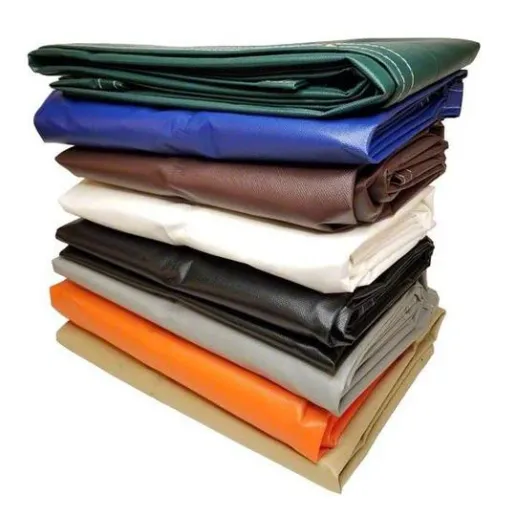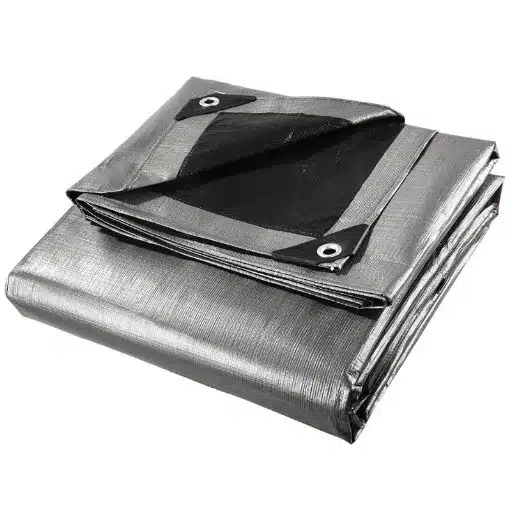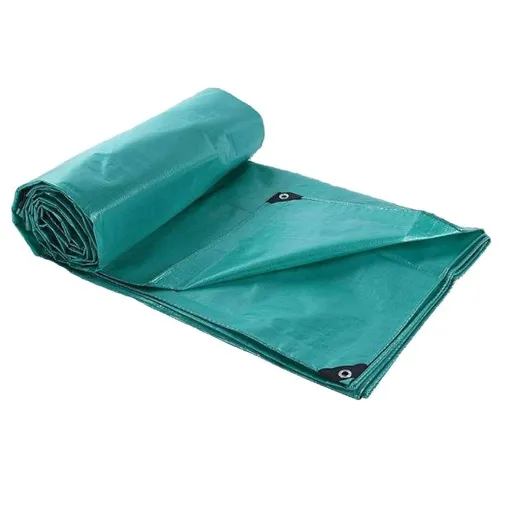PVC tarpaulin is a material that has been considered either in great use or simply versatile in application. From being used to cover loads while in transit to constituting major outdoor tent and billboard materials, the choice always remains on the sturdiness, flexibility, and adaptability of the PVC tarpaulins. However, when one compares PVC to vinyl, many are left wondering: Are they one and the same with just a different name, or are they two totally different things? In this blog post, we are going to dive into the world of PVC tarpaulin by breaking down what it is made of, exploring different aspects of PVC and vinyl, and showcasing some applications that truly make this material indispensable. This guide will provide the clarity and actionable insights to help business owners, logistics professionals, or just anyone who wonders about industrial materials decide on the right material.
Definition of PVC Tarpaulin
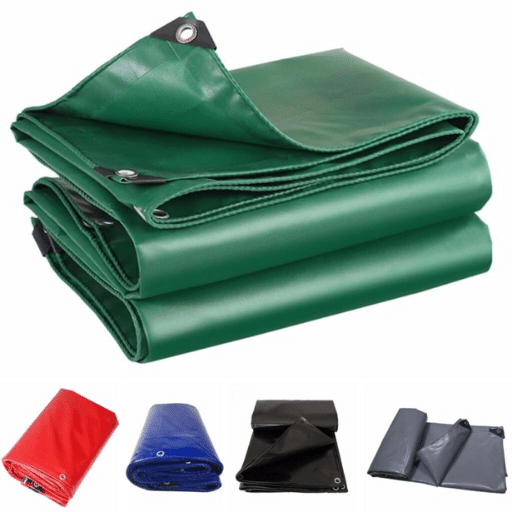
?
What is PVC?
PVC, or polyvinyl chloride, is a synthetic resin that is heavily hinged on its versatility, strength, and cost-effectiveness for its widespread applications. It is formed via polymerization of vinyl chloride monomers, and it could be either flexible or rigid depending upon the formulation kits. This conversatility allows it to be manufactured into all kinds of items-from pipes to flooring, medical devices to clothing. For a tarpaulin, PVC usually is mixed with plasticizers and other additives to improve flexibility and coated onto the fabrics in order to make a waterproof, weather-resistant material. It becomes a bestseller in most industries, including building, transportation, and agriculture, due to its strength, fire resistance, and an almost negligible maintenance requirement.
📊
Understanding Tarpaulin and PVC
The most recent data and insights show that the PVC tarpaulin has remained one of the most multifaceted and trusted materials due to its robust and adaptable nature. This nature of PVC tarpaulin makes it satisfy the waterproofing need that severely limits its performance in the extreme weather condition. Such shadowing applications include heavy-duty applications like truck covers, tents, and agricultural implements. Further, improvements in PVC formulations have addressed environmental concerns where certain manufacturers now use recyclable materials and low toxicity additives to address the same.
Being resistant to the onslaught of UV rays, chemicals, and abrasions made the material durable, thus less frequent replacements. In addition, it is light and sturdy, making it smooth to carry and set up, adding to its usability in building, event production, and logistics. This constant innovation and needs bolster the relevance of PVC in producing tarpaulin and keeping it abreast of industrial and consumer requirements today.
Key Characteristics of PVC Tarpaulin
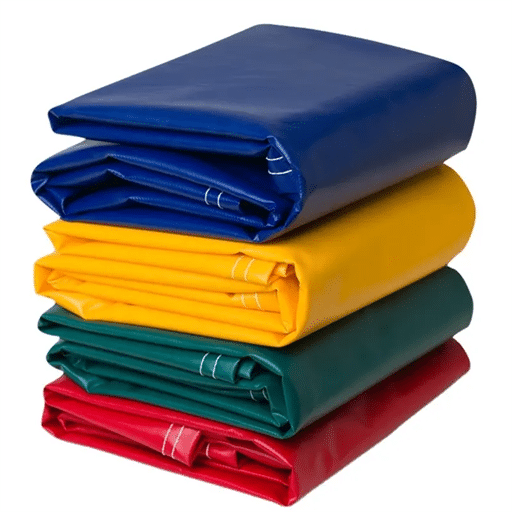
Because they offer durability and versatility, PVC tarpaulin finds its way into almost every industry. Prominent is its waterproofing characteristic, which makes it an ideal choice when expected performance criteria are set under adverse weather conditions. Resistance to UV radiations, chemical concoctions, and tearing comes to define it-thus offered protection and uses in areas requiring distance from the outdoors. Many times, PVC tarpaulins pass as fire-retardants and offer fire safety standards between construction and event planning.
The lightweight quality is enough for it to be bulky to handle, due to which transporting and installing it is easy. The material generally has customizations in thickness, color, and size to fill the diverse needs ranging from industrial covers to consumer products such as awning and tents. Being environmentally conscious, companies now are finding recyclable options and ways to make their products eco-friendly. Considering these properties and innovations, PVC tarpaulin is capable of fulfilling both kinds of requirements: function and beauty.
Common Applications of PVC Tarpaulin
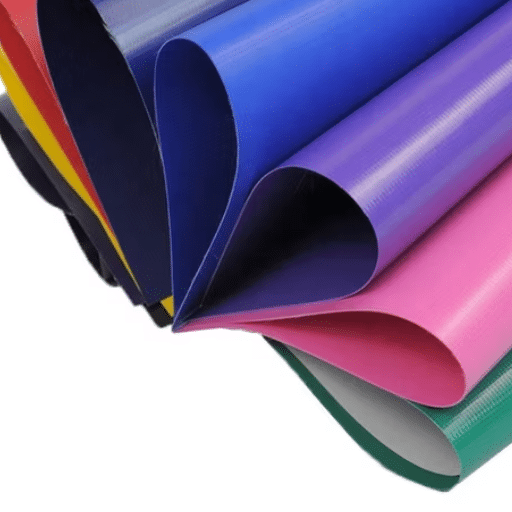
🏭
Activities and Industrial Applications
PVC tarpaulin enjoys wide utilization across many industrial and commercial sectors because of its strong, flexible, and waterproof characteristics. The most common applications are covering working areas, scaffolding sheeting, and machine protection. These covers protect equipment and materials against weather damage. In the logistics and transportation industries, PVC tarpaulin is used as covers for trucks and trailers to ensure that goods are safely and securely transported. Besides that, tarpaulins are used in warehouses to serve as temporary partitions or extra storage.
With the change in trend, PVC tarpaulin has made its demand grow in the agricultural sector, which is used as a greenhouse cover and pond lining. Customized PVC tarpaulins are now being used for banners, promotional tents, and stage coverages in the event and advertising industries that require extreme outdoor exposure. The manufacturers are also working toward making recyclable PVC as an answer for the environment, keeping in view the current sustainability measures in business.
🏕️
Uses Out-door and Recreational Settings
PVC tarps are one-of-a-kind materials that basically may be utilized outdoors and recreationally since they are very robust and highly adaptable. Very common applications are camping tents, ground covers, and awnings, for which weather durability is the major requirement. The tarps are also known to be raised to form shade sails in parks or playgrounds to equate to protection from UV rays and make areas comfortable. Manufacturers keep innovating to make sure the lighter, eco-friendly materials are used, and technology improves their waterproofing. According to search trends, more backyard projects such as pergolas or DIY-priced PVC tarpaulins are growing in the orientation of multifunctional, cheap outdoor solutions.
🎪
Specialized Applications in Events and Advertising
Being sturdy, customizable, and economical, PVC tarpaulins are highly appreciated in the events and advertising sectors. This versatile medium finds widespread application in putting together banners, event canopies on a grand scale, and branded tents to provide an attractive viewing platform for the clients’ promotional content. Recent data from search engines denotes that there is growing interest in customized prints for tarpaulins used in events such as weddings, community gatherings, and trade shows, indicating demand for a solution that combines functionality with artistic expression. High-resolution tarpaulins and hardy weather-resistant materials are in demand, signifying a preference among users for durable outdoor options that yield sharp and vivid visuals for promotional work. This growing trend lends a voice to tarpaulins as a supportive infrastructural medium while simultaneously being a vital promotional tool in the world of events and advertising.
Benefits of Using PVC Tarpaulin
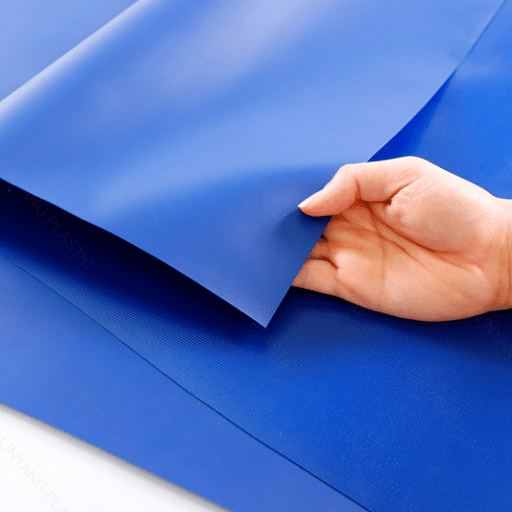
Manufacturing Process of PVC Tarpaulin
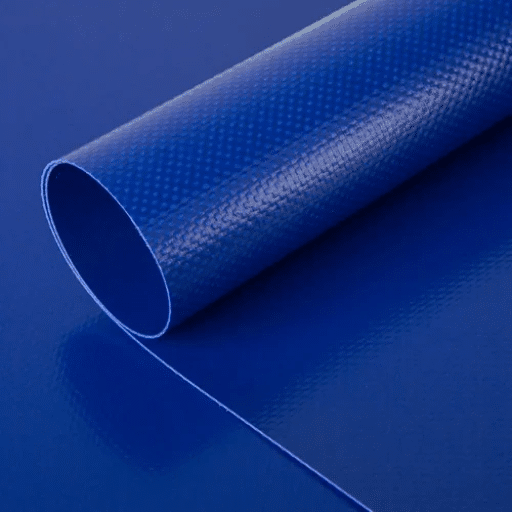
🧪
Raw Material Utilized
The manufacturing of PVC tarpaulin begins with the selection of materials of the highest quality to ensure the durability and performance. Polyvinyl chloride or PVC occupies the primary position in the list of raw materials. PVC is selected for the tarpaulin because it is flexible, weather-resistant, and strong. PVC resin is mixed with plasticizers to make the material more elastic and useful in various applications. Other constituents are stabilizers to prevent the degradation caused by UV rays and extreme temperature. Reinforcement fabrics, usually polyester, form the base layer and provide structural strength and tear resistance required for heavy-duty use. These raw materials, when combined correctly and with proper processing methods, make the product highly adaptable and dependable for both industrial and commercial purposes.
⚙️
Production Techniques
Being formed through a variety of advanced technologies and manufacturing processes, having requisite care in the preparation of good raw materials such as polymers and reinforcement fabrics before they go into production is the foremost step. Polymer extrusion, of the best regard, is used to apply an even coating to the surface of reinforcement fabric. This coating is regulated carefully in terms of thickness and durability. The lamination is done through heat and pressure, making sure that all bonding is perfect and through good-quality work. Cutting and finishing of materials are automated, adhering to defining dimensions. Eco-friendly and sustainable production have become more popular recently, with many producers inclined to biodegradable polymers and energy-saving solutions so that environmental care in manufacture does not get compromised against the supreme quality.
✅
Quality Control Measures
Quality control in a manufacturing setup is used primarily to make sure that an item meets industry standards and consumer expectations. From the already published articles about industrial manufacturing, current research trends, and news items using search engines, it is revealed that today the buyers tend to give importance to durability, safety, and environment while judging the quality of a product. Manufacturers are, therefore, adopting automated inspection systems in the production lines, which use AI and machine learning to detect defects with precision. Other quality assurance techniques perceived to align with sustainability include practices such as a reduction of waste or the utilization of renewable materials. By incorporating new technologies and raising environmental standards, companies make sure that they are listed as producers in competitive markets, and in line with consumer preferences.
Maintenance Tips for PVC Tarpaulin
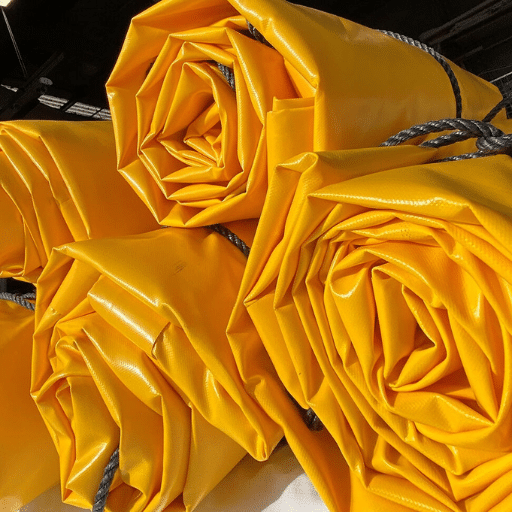
🧽
Cleaning and Care Instructions
To perform maintenance of PVC tarpaulin so as to ensure its longer life and efficient performance, the PVC tarpaulin should be cleaned by simply rinsing with clean water to remove surface dirt. For dirt that is a bit embedded, use a soft brush or sponge and mild detergent solution to clean. Never ever use an abrasive cleaner or high-pressure washer since such a treatment can damage the surface. The tarpaulin should be dried completely after cleaning before storage; otherwise, mold and mildew will develop. In case of stubborn stains, you may consider special PVC cleaning agents but always heed to the manufacturer’s instructions. Regular checking for cracks or frayed edges keeps the tarpaulin in good condition for extended use.
📦
Storage Recommendations
When storing your tarpaulin, it must be entirely free of dust or dirt and cervical; else, mold or mildew will set in. Fold it neatly and keep it inside some dusty old closet or barn where it is difficult to keep moisture away or, rather, anywhere out of direct sunlight. Some sort of cover or carry bag will then provide some protection for dirt or accidental damaging. Keep it away from sharp objects or chemicals so poor little tarpaulin does not deteriorate with the years. When keeping it for a long time, inspect the tarpaulin every once in awhile to ascertain that it is fine. Scriptures indicate that if stored well, the life of the tarpaulin can be extended by some years, thus assuring reliability and performance with age.
🔧
Fixing Damages
When it comes to fixing damages in a tarpaulin, it’s essential that the kind and severity of damage be first ascertained. Smaller tears or punctures can be mended with adhesive repair tape intended for tarpaulin materials. Make sure the surface is clean and dry before application for good adhesion. Larger damages like extensive rips might need patches of the same material that must then be glued on firmly, or sewn on with waterproof thread.
Based on the most recent search trends, many users suggest heat-sealing repairs to achieve permanency, especially for heavy-duty tarpaulins. Heat-sealing involves applying heat to bond the patch with the damaged area to form a seal that can withstand wear and tear. Besides, many people also take professional repair services for expensive tarps if the damage is too extensive to be undertaken at home. Hence, the timely application of suitable repair methods can substantially increase the life of your tarpaulin.
Comparing PVC Tarpaulin with Alternative Materials
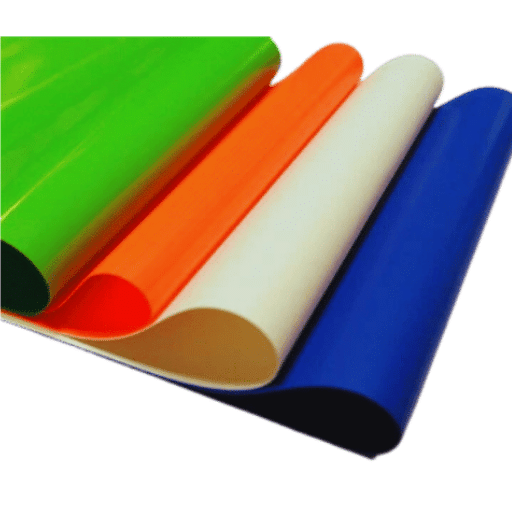
Difference Between PVC and PE Tarpaulins
Both PVC and PE tarps are popular materials used across various applications in different industries. However, they vary in composition, functionality, and suitability for specific applications. A PVC tarpaulin has a polyester base fabric coated with PVC on both sides, giving it superb durability, tear resistance, and waterproofing properties. Since the material has a strong prominent strength and dry wood resistance, it finds its heavy usage in truck covers, industrial curtains, and other long-term outdoor activities. Being reusable, PVC tarps can withstand severe weather; however, these tarps are relatively heavier as compared to PE tarp.
In the manufacturing process, PE tarpaulin is woven from fibers of HDPE or High-Density Polyethylene and laminated with LDPE or Low-Density Polyethylene on both sides. Being less dense and cheap, PE tarpaulins find use in temporary applications: camping, agricultural, or other short-term covering needs. The tarpaulins are water- and chemical-resistant but under certain conditions could be surpassed by PVC in long-term resistance, tear-resistance, or resistance to aggressive environmental elements. These less dense tarpaulins are easier to transport and handle.
Weighing the respective purposes and environmental considerations, the choices between the two depend very much on that. PVC tarpaulin is better for being resilient and strong for the long term. PE tarpaulins are practically efficient and great choices for lighter applications or for those operating on tight budgets. Both possess unique advantages that allow users to pick the one best suited for their own needs.
Pros and Cons of PVC Tarps Versus Vinyl Tarps
PVC tarps and vinyl tarps are often used interchangeably, but subtle differences exist between the two materials, which make them more or less usable and useful in specific scenarios. They both are strong and durable, yet knowing their pros and cons can help in making the right choice for a tarp.
✅
Pros for PVC Tarps
- Durability: These are tarps that are made to withstand or tear, making them useful for long-term heavy-duty use.
- Chemical Resistance: These tarps are resistant to chemicals, oils, and greases, thus advantageous for industrial applications.
- Weatherproof: PVC tarps provide very good protection against harsh weather conditions, including UV rays, rain, and high winds.
- Versatility: The alternatives prove very versatile and can find use in various industries, including construction, agriculture, and transport.
❌
Cons of PVC Tarps
- Weight: Generally, PVC tarps are heavier and harder to handle and install.
- Cost: Compared with other tarp types, they tend to be more expensive.
✅
Pros of Vinyl Tarps
- Strength: Being usually reinforced with polyester, vinyl tarps offer excellent strength and can be relied upon for heavy applications.
- Abrasion Resistance: Protecting against abrasion, these tarps ensure a longer service life in harsh conditions.
- Waterproofing: Vinyl tarps are perfect for excellent waterproofing needs, defending against water damage.
❌
Cons of Vinyl Tarps
- Cost: PVC tarps may demand quite hefty prices, thereby defying most budgets.
- Cold Stiffness: At extreme low temperatures, vinyl tarps lose flexibility and may thus be impractical in some climes.
Which One Should You Choose?
According to the present trends, PVC tarps are more commonly chosen by the industries that require more substantial protection and resistance to extreme elements, while vinyl tarps remain a very strong contender for application purposes requiring good strength and waterproofing. The decision of which to pick depends on their specific requirements like where the tarp is going to be used, what is their budget, and the duration for which they are going to use it. A long-term heavy-duty use calls mostly for PVC tarps, while for short-term maximum strength water-resistant applications, vinyl tarps should suffice.
Picking the Right Tarp for Your Needs
When picking a tarp for your needs, it is highly necessary to dip into several factors to ensure that the tarp will perform optimally for you. According to the latest insights, here are some critical points to evaluate:
🎯 Purpose and Application
Determine the tarp requirements such as industrial needs, the protection of construction materials, vehicle protection, and even serving as a shelter for outdoor events. Heavy-duty PVC tarps are made for heavier industrial tasks, while vinyl tarps would be suitable for waterproofing and moderate weathering requirements.
🌦️ Weather Resistance
If tarps are to be used in their projects outside, do consider the resilience of the material towards harsh weather conditions like UV exposure, rain, wind, or snow. PVC tarps can be treated for UV resistance and hence are mostly used for permanent installations in outdoors.
📏 Size and Thickness
Measure accurately for the area to be covered, and select the tarp size and thickness accordingly. Thicker tarps perform better in offering durability and strength, especially when it comes to heavy-duty use.
💰 Budget Constraints
A cheaper tarp may do for the light-duty and short-term requirements. For standard long use, however, it is quite cost-effective to invest in a more high-grade and durable tarp such as PVC.
Considering the factors one’s specific needs can help one-to make an informed decision on the ideal tarp to buy. It is by weighing these parameters that one achieves efficiency and value in an item purchased.
Frequently Asked Questions
Reference Sources
📚 University of Maine Extension
This publication discusses different types of tarps, including PVC tarpaulins, and their applications in fieldwork and solarization.
🏛️ U.S. Customs and Border Protection
This document provides detailed information about PVC tarpaulin materials, including their construction and features.
♻️ California Department of Resources
This resource lists PVC tarpaulin as a material type and provides insights into its recycling and disposal.

